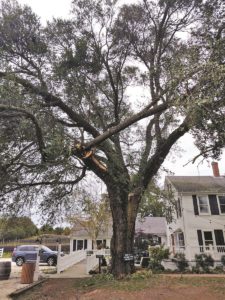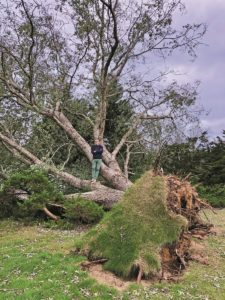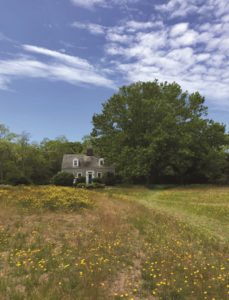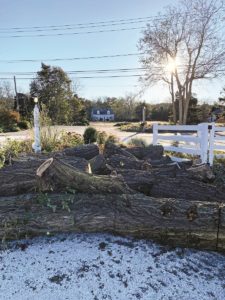TRURO — In the early morning hours of Oct. 27, the night of the recent nor’easter, a tremendous gust of wind came swooping down over the ocean, across the tops of waves, and up over the dune at Highland Light. It ripped through the pines, hunkered low, swept across the highway and over corduroy rows of grapevines, finally slamming into the tallest thing it met: a Siberian elm that had stood on the property that is now Truro Vineyards for about 150 years. The branches of the elm strained, gave, and broke apart, leaving the tree damaged beyond salvation.
The elm was a rare giant, 70 feet tall, with a spread of about the same. It watched over the property for generations, casting its shade over the great lawn. It was a steadfast anchor, holding enormous space, defining the landscape.

On a mild November day, Kristen Roberts, an owner of the family-run Truro Vineyards, sits down near the giant stump to tell the tree’s story. As is true with most stories about old trees, this one begins, “I don’t know for sure, but I was told….”
The story goes that Capt. Atkins Hughes, a previous inhabitant of the estate, planted the elm sometime between 1832 and 1870. It was planted at the same time as the well-loved Chinese mulberry that still stands on the great lawn.
“The trees came from overseas and were planted for the captain’s wife, Amelia,” says Roberts. “It’s a love story.”
When she drove to the vineyard the morning after the storm, Roberts remembers, “I felt it when I pulled in. It felt like a death.” She is not the only one mourning the tree. “We got so many emails saying, ‘I’m so sorry for your loss,’ ” she says, “the way you do when someone dies.”

In sight of the Siberian elm, just across a meadow of little bluestem, lies another tree. A giant silver maple, nearly 100 years old, is on her side, a massive hole torn in the earth where her roots broke and lifted from the ground. The silver maple had stood about 60 feet tall, with a giant canopy of the same width. It was planted around 1930, when the house it shaded was built.
Somehow, when the maple fell, it left the house unscathed. Its new owners, Stephen Orr and Chad Jacobs, will miss the tree. It was a presence and a personality on the property, they say, and it offered a connection to the history of the land. “We named the tree Jeanette,” Orr says, “after the original owner of the house.”
Orr says he imagines his maple and the elm across the street growing up together and notes the strange sadness of their both being taken by the same storm.

Looking over the leaves of the maple’s canopy, which just a few days before had waved far overhead, Orr admits he was anthropomorphizing the old trees. “We see them as old beings,” he says. “When they die, it’s like losing a wise old soul.”
Orr and Jacobs are searching for silver linings. They will build a vegetable garden where the old tree stood. And plant another tree. Farther from the house.
Back across the field of bronze seed heads waving in the breeze, stands the Vineyards’ Chinese mulberry, a survivor. It has been on a regular pruning, feeding, and maintenance program, as the elm had been, too, says Ken MacPhee, an arborist with Bartlett Tree Service and the man in charge of taking care of the trees.
“The elm had seven brace rods and was full of supporting cables,” says MacPhee. “We did yearly pruning on it to decrease its weight load,” he adds. “The mulberry is full of rods and cables, too. We feed it regularly. Old trees need that just like we need our vitamins as we get older.
“You look at older trees and all they’ve been through,” MacPhee says. “They’ve stood the test of time. It’s sad to lose them.”

The mulberry is a fairy-tale tree. It is perhaps only 40 feet high, but its span is nearly twice that. It is a snarl of limbs so sinuous and winding they appear to be in motion. “Supposedly, it’s the oldest fruiting mulberry in New England,” says Roberts. The tree glows in the night, wrapped in strings of elegant white lights, like a bride in a wedding dress, a celebration of her graceful mass.
People want to get married under this tree, Roberts tells me. “They want to be a part of its story, of the love story of these trees,” she says. “It’s a comfort to people.”

The mulberry is a story in physical form. It wears its scars in plain sight. Old trees bear all their wounds for anyone to see, and they are more stunning, authentic, and complex for it. We can see struggles overcome, losses endured, scars healed into beautiful knots. Old trees show us that our stories are what make us who we are.
They say it’s important to speak the names of our lost loved ones, as a way of keeping them with us. Orr, Jacobs, and Roberts are saving the wood from their fallen trees to build something special. That way, their stories will continue to be told.
